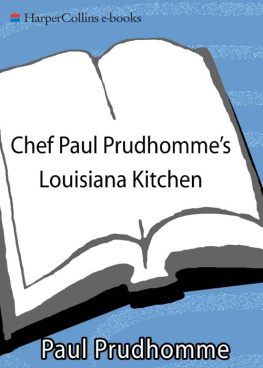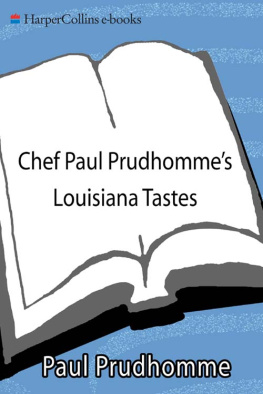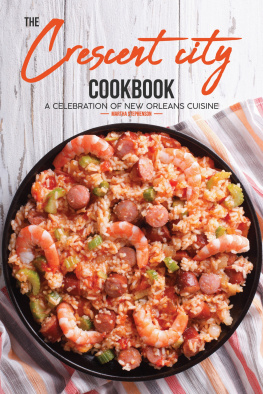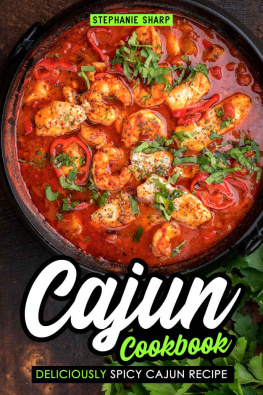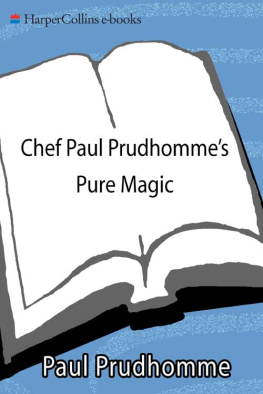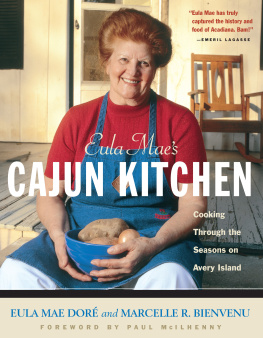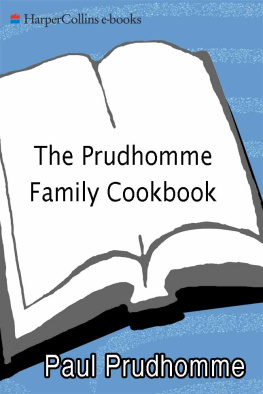To my wife, K. Hinrichs Prudhomme, who made this book possible, and to the memory of my mother, Hazel Reed Prudhomme, who taught me so much
CONTENTS
When the taste changes with every bite and the last bite is as good as the first, thats Cajun! Im a Cajun and thats Louisiana cooking.
Cajuns originated in Southern France, emigrated to Nova Scotia in the early 1600s and settled a colony that came to be called Acadia. In the mid-1700s the British drove them out of Nova Scotia and many of them migrated to Louisiana, where they were well received by the large population of French. They usually settled along waterways and turned to their traditional country practice of fishing, trapping and farming for a living. Two of my ancestors were among those Acadians who migrated from Nova Scotia to Louisiana. Some of their descendants settled around the area of Opelousas, where I was born.
I grew up the youngest of thirteen childrenten boys and three girls. My family worked the land as sharecroppers, farming on borrowed land and paying the landlord a third of the profits from the cotton and sweet-potato crops. (My father spent forty-two years farming, following a pair of mules.) We also raised our own vegetables and animals for eating.
Fabulous food is a part of Cajun pride. Its our tradition to always celebrate with food and to welcome guests with food and coffee. I was seven years old when I began cooking with my mother, when my youngest sister got married. The most important thing to my mother was the health of her family and the joy of setting a good table, and she was an awesome cook. Everybody thinks his mother is the best cookbut mine really was! She had to be, to prepare interesting meals day in and day out for such a large family. Cooking with her was like working for a small restaurant. It was incredible what she could do, especially considering that the best food we raised was sold. My mother also was a great storyteller, and she talked to me a lot about foodits lore, the different kinds of food and how theyre prepared. All of this is still an inspiration to me.
At the time I worked with my mother, I thought that it was just my job and that it was hard work. I know now that those years were a unique opportunity. The time I spent with her next to the stove, in the fields digging up roots and vegetables, and in the barnyards feeding and slaughtering animals provided me with an exceptional experience. As Ive gotten older, Ive realized how important living close to the land was and how real it wasnot only for me and my family, but for all the people who live close to the land.
When I was seventeen, not fully knowing what was happening, not realizing why, I set out to become a cook. (The only thing I knew for sure was that I enjoyed eating!) I traveled around the country for twelve years, working full time at restaurants with chefs of every professional and ethnic background. In addition to learning new techniques and methods and the cuisines of various parts of the country, I shared my own heritage of cooking by fixing Cajun and Creole dishes. I was struck by the reactions to my food, from people all over the country. I began to understand how unique the traditional foods of my family were. I came to realize that the joy of cooking Cajun and Creole food was not just that I appreciated its goodness so much, but that there was this great pleasure I got from watching other people eat it and seeing the joy in their eyes. At the same time, I would notice when I returned home for visits that my Cajun family and friends didnt seem to recognize the uniqueness of their cooking. I felt it was one of those situations where if you see something every day, you dont see it; if you taste something every day, you dont realize that its unique.
Thats one of the things that led me back to Louisiana. And I decided that Louisiana was the place to cook, not only because it was important to me to keep the Cajun culture alive, but because the most creative cooking in the nation was going on in Louisiana. Cooks and cooking as an art were most appreciated here.
Louisiana is a terrific setting for a cook because of its bountiful natural resources, including a variety of wildlife and a wealth of fresh seafood that is extraordinary because of the states diverse water resources: the brackish waters in the coastal wetlands and in many of the southernmost lakes, the salt water of the Gulf, and the freshwater lakes and streams throughout the state. Also, our subtropical climate produces a taste in fruits and vegetables that is unmatchedwhen the taste is there, its just really staggering!
It took me many years to understand that it was the use of local fresh products that was the single most important factor in good eating. One of my strongest memories of my mothers cooking is her use of only fresh ingredients. We had no refrigeration, so wed go out in the fields to get what we needed. When we dug up potatoes, within two hours theyd be in the pot, cooked and eaten. I couldnt seem to get a potato to taste like my mothers until I realized that it wasnt anything that was done in the kitchenit was just the freshness of the potato that made it completely different. This principle carries over to all foods.
The ingredients in Cajun food have always depended on what you could get, so it changed depending on where you were. If you lived near New Orleans or the coast, you used seafood. But where we lived, there was no salt water and no transportation to reach it, so we had crawfish, which live in sweet water; and we had an endless supply of game, and there was chicken, pork, beef and all kinds of vegetables.
Cajuns still make use of the plentiful crawfish, as well as chicken and pork (which is frequently smoked) and seasonal game. Fil powder, parsley, bay leaves, cayenne and black peppers and a variety of other hot peppers are the primary seasonings. Rice, an abundant Louisiana crop, is a staple of Cajun cooking.
People often ask me whats the difference between Cajun and Creole cooking. Cajun and Creole cuisines share many similarities. Both are Louisiana born, with French roots. But Cajun is very old, French country cookinga simple, hearty fare. Cajun food began in Southern France, moved on to Nova Scotia and then came to Louisiana. The Acadians adapted their dishes to use ingredients that grew wild in the areabay leaves from the laurel tree, fil powder from the sassafras tree and an abundance of different peppers such as cayenne, Tabasco peppers, banana peppers and birds-eye peppers that grow wild in South Louisianalearning their uses from the native Indians.
The evolution of Creole cooking, just like the Cajun, has depended heavily on whatever foods have been available. But Creole food, unlike Cajun, began in New Orleans and is a mixture of the traditions of French, Spanish, Italian, American Indian, African and other ethnic groups. Seven flags flew over New Orleans in the early days, and each time a new nation took over, many members of the deposed government would leave the city; most of their cooks and other servants stayed behind. The position of cook was highly esteemed and the best paid position in the household. Those cooks, most of whom were black, would be hired by other families, often of a different nationality. Of course, the cooks would have to change their style of cooking. Over a period of time, they learned how to cook for a variety of nationalities, and they incorporated their own spicy, home-style way of cooking into the different cuisines of their employers. This is the way Creole food was created. Creole cooking is more sophisticated and complex than Cajun cookingits city cooking.

